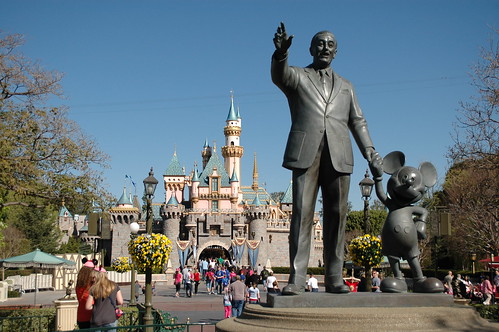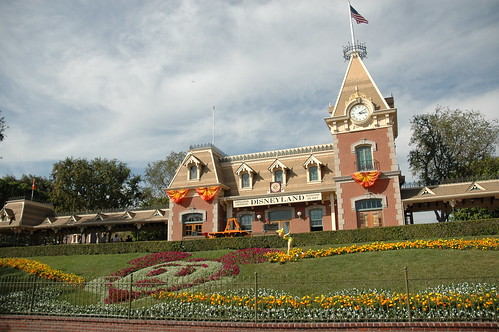Saving Mr. Banks is a new film from Walt Disney Pictures that dramatizes the development of Mary Poppins. The screenplay, from relative unknown writers Kelly Marcel and Sue Smith, follows the pre-production meetings and constant disagreements between author P.L. Travers and Walt Disney and his staff.

Academy Award-winner Emma Thompson (1992's Howard's End) plays the lead role of a writer wedded to her work but in need of financing. She has been receiving yearly requests for two decades to adapt her beloved children's book for a silver screen treatment by Walt Disney. After staring blankly at her typewriter and some nudging from her agent, she agrees to take a two-week trip to LA in 1961 to listen to the pitch. Thompson's Travers clings to her creation like a prized possession, and has a specific vision in mind for Poppins. She enters the meetings vehemently opposed to her character being given a musical treatment, and absolutely against it becoming an animated feature.
Walt Disney, played by Tom Hanks, does everything he can to woo the curmudgeonly stubborn writer. From a suite full of stuffed Disney characters and assorted gift baskets to cakes, donuts, and Mickey-shaped Jell-O at production meetings, to a private car with a charming chauffeur played by Paul Giamatti, Walt does everything he can do to make Mrs. Travers happy. Did I mention that Walt went to all of these lengths, along with oodles of pre-production, without even having a signed agreement giving his company production rights to the property? He did, after all, make a promise to his daughters that he would make Mary Poppins a reality. Disney introduces Travers to Don DaGradi (Bradley Whitford of "West Wing" fame) and the Sherman brothers (Jason Schwartzman and B.J. Novak), who begin to lay out their vision for Mary Poppins. Unfortunately for them, Travers is disgusted with the treatment, right down to the mustache on the family patriarch's face.
The audience is left to wonder why Travers, an imaginative storyteller, would be so untrusting of Disney and his staff, and why is she so distant and reserved. Director John Lee Hancock (The Blind Side and The Rookie) choses to reveal the development of Mary Poppins chronologically weaved in with flashbacks of Travers' childhood growing up in Australia with her parents (Colin Farrell and Ruth Wilson) and siblings. Farrell's father character lends insight into the source of Travers' imagination, but is far from a perfect role model.
Bring a period piece, Saving Mr. Banks features some wonderful costumes and props from Travers' childhood (turn of the 20th century) along with the early 60's. Disney and theme park fans will salivate over the level of detail in Walt's office and the look of the 60's-era Disneyland costumed characters. The producers even performed some principal photography in Disneyland, as in one scene, Walt invites Travers to the park to demonstrate his devotion to storytelling.
Travers initially scoffs at the invitation, calling Disneyland Walt's "personal dollar printing machine." Theme park fans are probably going to want to see more of Disneyland in this movie, but the park is rarely featured on film, and aside from Escape From Tomorrow, a film that may never get a wide big-screen release, Saving Mr. Banks provides the most extensive views of the park albeit for only about 6 minutes.

I don't think I'm giving anything away by saying that Travers eventually concedes to letting Disney make Mary Poppins, and the rest, they say, is history. Ultimately, the story is more about storytelling and family than the casting of Dick Van Dyke and animated penguins. Hanks' Disney is a little strange, probably caused by his identifiable look and portrayal of so many other historical figures (Jim Lovell, Carl Hanratty, Charlie Wilson, and the very recent captain Richard Phillips). He tries to summon Disney through his voice and characteristic syncopation, but it just didn't ring true for me. On the other hand, Thompson's Travers is mesmerizing, despite being an overly hyperbolic character. Farrell, Whitford, and Schwartzman provide strong supporting performances, but Giamatti was an under-utilized, yet key character.
The movie also features much of the music from the original movie, which audiences will be singing along with and humming long after the credits have stopped rolling. Scenes of the recently restored film (for its 50th anniversary Blu-Ray release) are shown at the end. Despite being a late-year release, Saving Mr. Banks probably won't garner any Best Picture award nominations, but it's possible that Thompson may receive recognition for her superb performance. Despite the limited length of Disneyland's appearance in the film, theme park fans, and especially Disney fans will really enjoy this movie.
Tweet
I like Hanks's Walt too, though. But he's just a supporting role, in my opinion, the true star is Emma Thompson.
I saw Frozen recently and Tangled, not so recently. They are both terrific movies. Unfortunately, they don't even resemble their source materials. Not even close.
If "Saving Mr. Banks" is accurate, it will be a rare event.
This article has been archived and is no longer accepting comments.
As mentioned in the article the period pieces, Walts railroad ties & office etc, were fascinating.